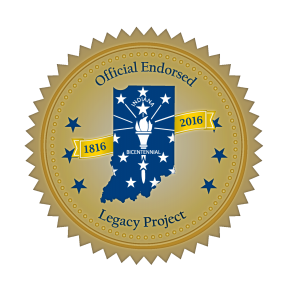IF THE RIVER COULD TALK
RIVER FORDS
Getting Across the White River Not Always Easy at These Three Fords
This photo taken around 1900, shows an unidentified woman seated upon the dam constructed for the mill race that supplied water to the Moss Island Mill. It is believed the dam was built over the existing ford.

It is located where Raible Avenue crosses the river today. In the 1870s, J. Whitinger owned considerable property in the immediate area and most likely was the source of the name for the ford. There is an account of a tragic event associated with this ford.
It was Friday, September 4, 1874, the final day of the seventh annual Madison County Fair. Forty-eight-year-old Simeon Gooding, his wife and their two grandchildren were returning home after a day of enjoying the fair. After leaving the fairgrounds, they made their way west on the Anderson-Hamilton Turnpike(Eighth Street) in a common road wagon pulled by a harnessed team of small mules. After traveling a mile, they turned north on an old dirt road that led to White River and the Whitinger Ford.
After crossing the ford, the road ascended a steep hill. While making the climb, the team of mules came to a complete halt, probably from exhaustion. Topped on the steep incline, the wagon began to roll backward. Mr. Gooding jumped clear of the wagon and fell to the road. Mrs. Gooding threw one of the children out, grabbed the other in her arms, jumped and landed in a ravine beside the road. The wagon then turned over, landing on Mrs. Gooding and the children. Fortunately, the three of them were not seriously hurt, however, that was not the case for Mr. Gooding.
Apparently he struck his head during the fall, knocking him unconscious. He was resuscitated after considerable effort, and with the aid of friends who had arrived on the scene, he was taken to a nearby house where he died before medical assistance could arrive.
A Tough Crossing
Dripping wet, Hill continued to the wedding where he obtained dry clothes and performed the ceremony. Afterward, he enjoyed a warm meal before heading home. Needless to day, he did not ride the pony.
If the river could talk, it would reveal that the Whitinger Ford provided people traveling west to the Moss Island Mill a viable option as opposed to continuing west on the turnpike where it intersected with a road (Baxter Road) that led to the Moss Island Ford, the seventh ford in the series. It had the reputation of being a bad ford, even when the water level was low. When the water level was high, a canoe was kept there to ferry people across.
People using the Whitinger Ford and crossing to the north side of the river had the option of following a road (North Shore Boulevard) that took them to the Moss Island Mill. Another old road (Van Buskirk Road/North Shore Boulevard) began on the west side of the Fair Ground Road (Madison Avenue) north of the Fair Ground Road Ford and continued westward. It intersected with the Whitinger Ford road at the top of the steep hill where it continued until reaching the Moss Island Mill. That intersection today is Raible Avenue and North Shore Boulevard.
An amusing tale have survived about the treacherous Moss Island Ford. In January 1867, the minister of Anderson Methodist Episcopal Church was John Hill. He was very popular with his congregation on Meridian Street and with people living in the county. His popularity often led to his performing marriage ceremonies.
He had been asked to perform a wedding ceremony at the farm of Joshua Chappell near Moss Island. Several Anderson people were invited and made their way in carriages to the Sunday night wedding. The Reverend Hill followed, riding a pony. If the river could talk, it would tell that the night was dark and there being a January "thaw," the river was up, boiling, seething, and foaming!
The first carriage in line was driven by Frank Demott, who knew the ford so well that all the carriages crossed safely, although some came close to going under several times. The ford ran on a diagonal across the river, exiting on the opposite bank several feet downriver from the starting point. When the minister reached the river, his pony was understandably scared and anxious. The pony plunged in, and in its haste to join the other horses on the opposite side, proceeded straight across the swollen river instead of following the angled ford. Soon it was in water 10 to 12 feet deep, and well over the head of both itself and rider.
Other Fords Nearby
Stephen T. Jackson, Madison County Historian
The Anderson-Perkinsville Turnpike (Moss Island Road) began at the Moss Stone Quarry. Several miles west, the turnpike came to the river and was forced to made a 90-degree bend to the north. On the opposite side of White River, the Anderson-Hamilton Turnpike made a similar turn north and descended a hill coming fairly close to the river before turning abruptly west in the direction of Hamilton.
Down at the bottom of this hill, there once was a road that led down to the river and the ford. Old-timers can recall hearing of two men who attempted to use the ford when the waster was up and were drowned.

Throughout Indiana's Bicentennial year of 2016, Steve Jackson, Madison County Historian, will be authoring "If The River Could Talk." This series will feature people, places, and events that takes place in and around White River.
The series is an officially endorsed legacy project of the Indiana Bicentennial Commission.
Madison County Historical Society|15 West 11th Street, P. O. Box 696, Anderson, Indiana 46015-0696|(765)683-0052|madisonchs10@gmail.com